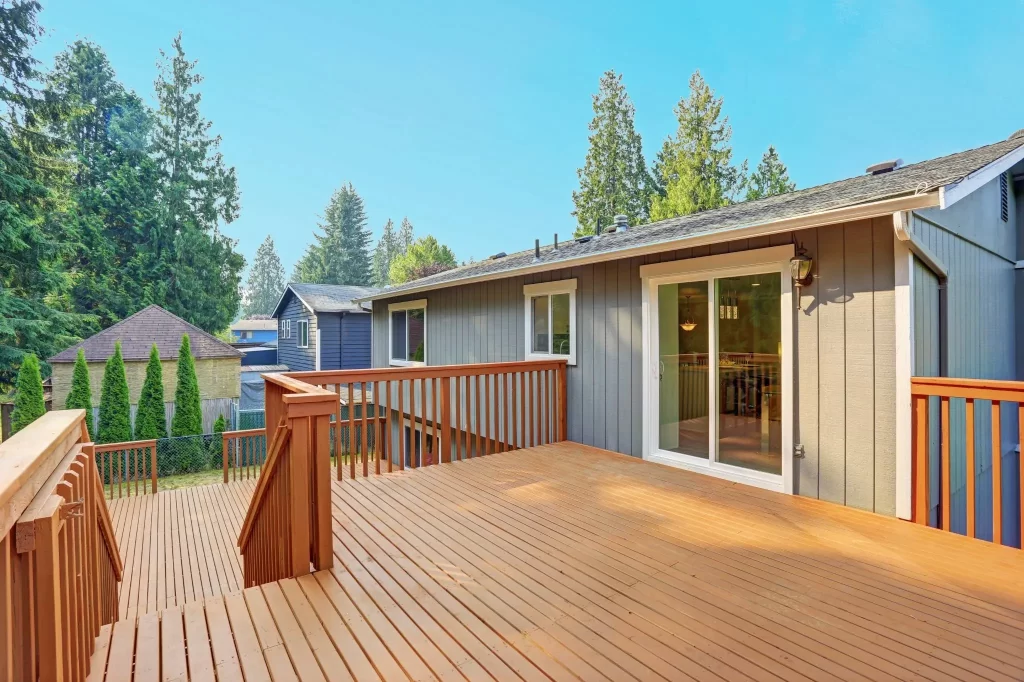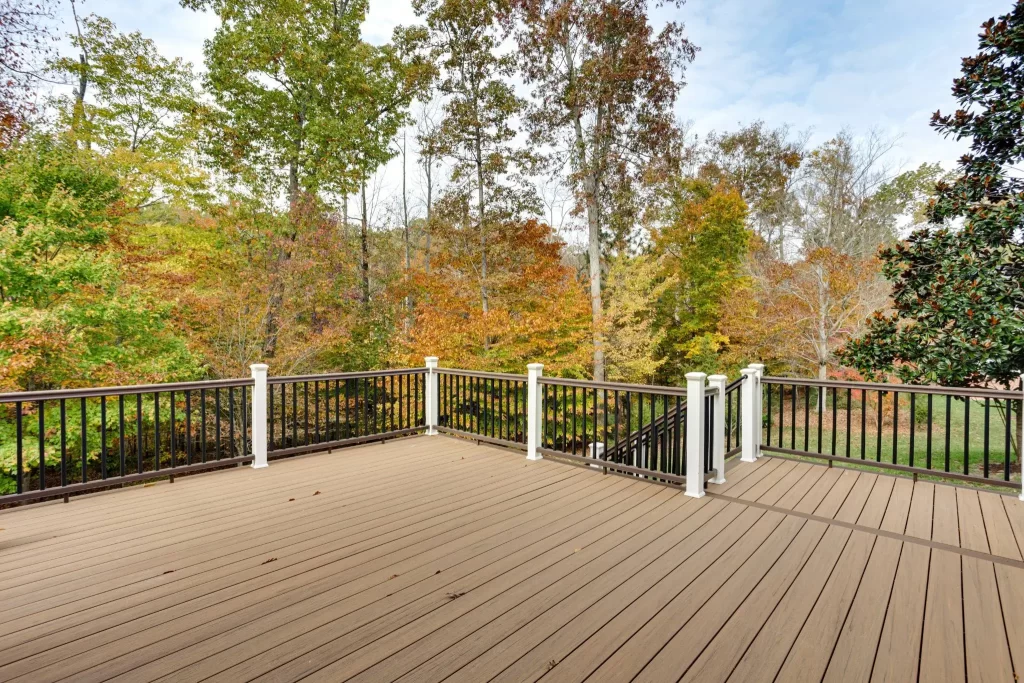Living near the Missouri River offers breathtaking views and a unique lifestyle, but it also comes with its share of challenges — primarily, the risk of flooding. Homes in flood-prone areas need to be specially designed to protect against the occasional (and sometimes inevitable) high-water events.
One of the most effective ways to safeguard your property, especially your deck, is by building an elevated deck.
Elevated decks are a fantastic option for homes near the Missouri River, where flooding is a consistent threat. Not only do they provide a beautiful outdoor space with an unobstructed view of the river, but they also help to mitigate the impact of floodwaters.
Whether you’re looking to build a new deck or elevate an existing one, it’s essential to understand the best design features and materials that can make a real difference in protecting your investment.
In this post, we’ll cover everything you need to know about elevated decks, including the benefits, design considerations, and the best materials to use for homes near the Missouri River. If you’re a homeowner in a flood-prone area, this guide is for you.

Why Elevated Decks are Perfect for Flood-Prone Areas
Flooding is a significant concern for homes along the Missouri River. With the potential for heavy rainfall, snowmelt, and spring river surges, it’s important to consider designs that can withstand water damage. Elevated decks are an ideal solution for several reasons:
- Flood Protection: The main benefit of elevated decks is that they raise the living space above the floodwaters. By positioning your deck on piers or stilts, it prevents the deck and its foundation from being submerged during floods. This is particularly important in areas where river levels can fluctuate drastically.
- Improved Airflow and Ventilation: Elevated decks allow for better air circulation beneath the structure. This not only helps with drying out wet materials more quickly after flooding but also reduces the likelihood of mold and mildew buildup.
- Increased Home Value: Elevated decks are not only functional but also aesthetically pleasing. By offering spectacular views of the Missouri River while also offering safety from flooding, you enhance your property’s appeal and value.
Key Design Features for Elevated Decks in Flood-Prone Areas
1. Foundation Design: Piers vs. Concrete Footings
The foundation of your elevated deck plays a pivotal role in both its stability and flood resilience. In flood-prone areas, you have two primary options for building the deck’s foundation:
- Piers: Concrete or steel piers are the most common foundation for elevated decks in flood-prone regions. These piers elevate the deck above the floodplain, keeping the deck safely out of reach of rising waters. It’s important to space these piers appropriately to ensure the deck’s stability and to allow floodwaters to flow freely around them.
- Concrete Footings: For homes with a higher risk of flooding, concrete footings provide a more robust foundation. These deep, embedded foundations help secure the deck to the ground, making it resistant to shifting or tilting during heavy flood events. However, it’s crucial to ensure that footings are raised to a level above the anticipated flood level to prevent damage during a flood.
2. Materials: Durability is Key
When building a deck near the Missouri River, choosing durable, water-resistant materials is essential. These materials must withstand exposure to high humidity, floodwaters, and temperature fluctuations. The following materials are best for flood-prone decks:
- Pressure-Treated Wood: Pressure-treated lumber is a classic choice for deck framing and floorboards. It’s treated with chemicals to resist moisture, rot, and insect damage, making it a solid option for homes near the Missouri River.
- Composite Decking: For homeowners looking for a low-maintenance option, composite decking is an excellent choice. Made from a mix of wood fibers and plastic, composite materials are resistant to mold, mildew, and moisture, making them ideal for flood-prone areas. They also don’t splinter, which makes them safer and more durable.
- PVC Decking: PVC is another great material for flood-prone decks. It is completely waterproof and resistant to rot, mold, and mildew. PVC is also extremely durable, making it a great choice for areas with frequent moisture exposure.
3. Deck Height: Elevating Above the Floodline
The height of your elevated deck is crucial for its flood resistance. To prevent water damage, the deck needs to be elevated sufficiently above the anticipated flood line. While flood zones vary, a common guideline is to raise your deck at least one to three feet higher than the base flood elevation (BFE).
This will provide the necessary protection to avoid water seeping into the deck structure. However, it’s important to check with local authorities regarding floodplain regulations in your area to ensure compliance with the building codes. The city may have specific height requirements to ensure that structures can withstand floodwaters.
4. Openings and Ventilation
A well-ventilated deck is critical for flood-prone areas. Without proper airflow, moisture can accumulate under the deck, leading to mold and mildew growth. For elevated decks, ensure that there are adequate spaces between the foundation and the deck floor to allow for proper drainage and airflow. This also prevents the build-up of stagnant water, which can cause damage to your deck over time.
5. Waterproofing and Sealants
Even with elevated decks, floodwaters can bring excess moisture. To protect the deck from water damage, it’s essential to apply a high-quality waterproofing sealant to the deck boards and railing. This protective layer will help prevent water from penetrating the wood, reducing the risk of swelling, warping, and rot. Sealants should be reapplied every couple of years to ensure maximum protection.

Best Deck Designs for Homes Near the Missouri River
1. Multi-Level Decks
A multi-level deck is a fantastic design choice for homes near the Missouri River, especially if you have a steep or sloped yard. These decks create more usable outdoor space and can help elevate the structure higher above floodwaters. Multi-level decks also give you the option of creating zones — such as dining, lounging, or gardening areas — on different levels, each of which can be protected from flooding.
2. Floating Decks
A floating deck is another great option for homes near the Missouri River. Unlike traditional decks that are anchored to the ground, floating decks are supported by concrete blocks or pads placed directly on the ground. This design allows the deck to “float” above the surface of the land, making it a flexible option that can move slightly with the ground.
These decks can be an ideal solution if your property is prone to minor flooding but doesn’t experience the extreme conditions where piers are necessary. They can be elevated slightly above the floodplain but are easier to remove or relocate if floodwaters reach dangerous levels.
3. Covered Decks
If you’re concerned about the impact of rainfall and constant exposure to the elements, consider a covered or screened-in deck. Adding a roof or canopy to your elevated deck not only provides shelter from the rain but also shields your deck from the sun, which can cause weathering and damage over time. Additionally, it adds a layer of protection against debris carried by floodwaters.
Best Manufacturers for Elevated Deck Materials
When building an elevated deck near the Missouri River, choosing the right materials is crucial. Here are some of the top manufacturers offering high-quality products that stand up to flood-prone areas:
1. Trex
Trex is a leading manufacturer of composite decking, offering long-lasting, weather-resistant boards ideal for flood-prone areas.
2. TimberTech
TimberTech provides durable, low-maintenance decking materials, known for their resistance to moisture, mold, and mildew.
3. AZEK Building Products
AZEK specializes in PVC decking, offering strong, waterproof materials perfect for flood-resistant elevated decks.
4. Fiberon
Fiberon manufactures eco-friendly composite decking, designed to withstand moisture and extreme weather conditions, ideal for flood zones.

Best Practices for Floodproofing Your Elevated Deck
Here are some additional tips for floodproofing your elevated deck:
- Use Flood-Resistant Landscaping: Landscaping is an essential part of floodproofing. Use native plants and trees that can withstand the occasional flooding, helping to stabilize the soil around your deck’s foundation.
- Install Sump Pumps: If you live in an area with frequent flooding, a sump pump is an excellent addition to help prevent water from pooling around your deck or house.
- Secure Furniture: When flood warnings are issued, make sure to bring in any deck furniture or other items that could be swept away or damaged.
Trust the Experts for Your Elevated Decking Needs
Our team has years of experience delivering top-notch elevated decking solutions. Work with the best to save money and ensure lasting results. Contact us at (402) 369-5724 to get your deck building project started!
